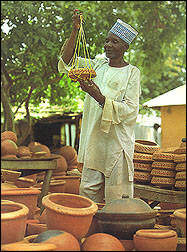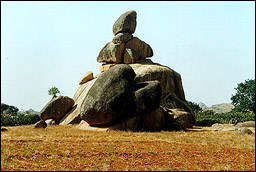 What to see What to see

 Abuja Abuja
The new beautiful capital city of Nigeria was created in response to the determination of the Nigerian government to find a lasting solution to the intractable problems of Lagos, the former federal capital city.
In 1976, the government in response to the recommendation of the panel earlier set up to advise on the desirability or otherwise of establishing an alternative federal capital city for Nigeria. With the movement of the seat of the Federal Government to the city in 1986 Abuja assumed the status of the administrative and political center of Nigeria.
The various hills such as Gwagwa Hills, Chukuku Hills, Agwai Hills and the famous Zuma Rock offer unlimited opportunities for mountaineering. Its serenity has attracted the hosting of many international conferences and seminars in the city.
Hotels: Nicon Noga Hilton Hotel, Sheraton Abuja
 Lagos Lagos
On Lagos Island, has been settled since the 15th Century, when Yoruba groups used it as a refuge from outside attacks. It was a trading post between the Benin Kingdom and the Portuguese until the arrival of British traders in the 19th century, presaging the colonization of the interior.
Lagos is divided into several parts, each with its distinctive character. The heart of the city is Lagos Island (Eko), containing most of Nigeria's commercial and administrative headquaters. It is linked to the mainland by three road bridges, and to Ikoyi Island and Victoria Island by road. The latter are mostly residential areas with palatial houses, expansive gardens and five star hotels in a gorgeous setting. Tourist attractions in the city include The National Museum, The National Theater and miles of beautiful beaches. Finally, Oba's Palace sits majestically on Lagos Island, portions of which are over 200 years old with a newly constructed extension.
There are various beaches one can get to by boat or car which are worth going to and relax.
Bar Beach, also known as Victoria Beach, is the most popular beach among Nigerians. The main beach on Victoria Island is located along Ahmadu Bello Way opposite the federal Guest House. It is usually crowded with Nigerians on public holidays.
Tarkwa bay is a sheltered beach along the Lagos harbor. It is accessible by a "trazan" boat from Morocco or a "fiki" boat from under Falamo Bridge on Victoria Island. This beach provides a pleasant outing with safe swimming conditions, even for small children. Tourists may obtain deck chairs and an awning on the beach, for relaxed, casual comfort. Local vendors sell delicious pineapples, coconuts and a variety of other delightful treats.
Lekki Beach is another of Lagos' attractive beaches and remains popular with foreign tourists. Beach shelters made of palm fronds and umbrellas, available for rent, keep the sun at bay, as well as provide a place to enjoy snacks or refreshments sold by local traders.
Eleko Beach opened in 1989 and is the newest of Lagos' beaches, down the Lekki Peninsula about 30 miles from Lagos. There are no traders and no distractions on Eleko Beach, just peace and tranquility, ideal for those seeking privacy.
 Bauchi Bauchi
Is an old Hausa town surrounded by an appealing range of rolling hills, is close to both the Yankari Game Reserve and the site of the Geji Rock Paintings, located on the Bauchi-Jos road. In Bauchi, tourists may also visit a memorial and library dedicated to Sir Abubakari Balewa, the first Prime Minister of Nigeria, who was assassinated in 1966. the library houses many of Balewa's personal papers.
 Benin City Benin City
Benin City is steeped in history. World-renowned Benin bronze sculptures date back to the 15th Century when the Oba of Benin ruled the large and powerful Edo kingdom, a period when bronze casting was an art used to glorify the Oba. In 1987, a British expeditionary force sacked Benin and hauled off many of the bronzes to London. Still, several good examples of the bronze artifacts remain in both the Benin and Lagos Museums. Today, bronze casting is still continued in several streets in the city, including Igun and Oloton streets. Another attraction in Benin is Chief Ogiamen's House, a prime example of Benin traditional architecture built before 1897. The house miraculously survived the "Great Fire" during that period which destroyed most of the city.
 Calabar Calabar
Calabar is an attractive city on the bank of the New Calabar River, near its confluence with the Cross River, near its confluence with the Cross River, near its confluence with the Cross River, which has a long history as the regional port of eastern Nigeria. Residents here trace their ancestors back to Babylon before the time of Christ.
First visited by the Portuguese at the end of the 15th Century, Calabar is also the center from which many missionaries ventured forth in the 19th and 20th centuries, including Mary Slessor, who arrived in Calabar in 1875.
Places of interest include the National Museum in the old Residency Building. The building was prefabricated, shipped from Britain and erected atop Consular Hill in 1884, later known as Government Hill. The museum itself is history, a vibrant colonial style citadel commanding superb views of Calabar and the Calabar River. The museum traces the history of Calabar and the surrounding areas in a spacious setting. |  Jos Jos
This has always been a popular destination for tourists due to its height above sea level. Jos has two golf courses, Rayfield and Plateau, plus a polo club and other sports/entertainment offerings. The National Museum in Jos is one of the best in Nigeria, especially for archaeology and pottery, where many fine examples of Nok heads and artifacts, circa 500BC - 200AD, are displayed. The pottery hall has an exceptional collection of finely crafted pottery from all over the country. On the same grounds, the Museum of Architecture contains life-size replicas of Nigerian architecture, from the walls of Kano to the Mosque at Zaria to a Tiv village.
Other attractions in the area include the wildlife park, nestled amid 8sq. km of unspoiled savanna bush, where the rare pygmy hippopotamus is successfully being bred in "hippo pool".

Lions roam a large enclosure that simulates their natural habitat and visitors will also find elephants, red river hogs, jackals, chimpanzees, crocodiles and numerous other animals to view. The Shere Hills can be seen to the east of Jos and offer a prime view of the city below. Assop falls is a small waterfall which could make a pleasant picnic spot on a drive from Jos to Abuja. Riyom rock is a dramatic and photogenic pile of rocks balanced precariously on top of one another, with one resembling a clown's hat, observable from the main Jos-Gimi road. Falls is a refreshing area for walks picnics, with scenery reminiscent of the Scottish highlands.
 Kaduna Kaduna
Previously the colonial capital of northern Nigeria and located on the Kaduna River, the city serves as an important junction, with roads extending in five different directions. Kaduna is a major communications center and industrial base but also a thriving metropolis from which tourists can explore the surrounding countryside. Within Kaduna there is a National Museum on Ali-Akilu Road that features and Benin bronzes. Plans are under way to have an annual Durbar festival in Kaduna like the 1977 Durbar, festival that drew all the northern Emirs to Kaduna.
 Kano Kano
This is the oldest major city in Sub Saharan Africa, dates back more than a thousand years. For centuries it was one of the most active commercial centers in West Africa. Today, it is Nigeria's third largest city in the north. Cenraly located, Kano City acts as a terminus for all northern Nigeria, linked by road and communications with all other major population centers in the region. By virtue of its historic role as trading center between the Sahara, down south to Zaria, Kano remains a living, modern day relic of a rich past.
The Emir's Palace in Kano is the past incarnate with its old stone walls and entrance gate, at the heart of this ancient city, encircled by a wall that extended 17.7km in circumference, with 16 different gates. Close by, the Gidan Makama Museum offers an excellent history of Kano Central Mosque is one of the largest in Nigeria and, with permission, a visitor may be allowed to ascend one of its towering minarets to gain a spectacular view of the city below.
 Katsina Katsina
The northernmost city in Nigeria, sits on the edge of Sahel and borders the neighboring country of niger, which has traded with her for centuries. Kastsina, one of the old walled Hausa cities, is the capital of Katsina State. The Goborau Minaret, a most picturesque tourist attraction, is the tallest mud-brick building in Nigeria and is 250 years old. A fine view of Katsina can be gained from the top, an area that hosts the best and most elaborate of Durbar festivals.
 Ondo Ondo
This area has many fascinating tourist attractions including the Ikogosi Warm Spring, Idanre Hills, Ipolo-Iloro Water Falls, Ebomi Lake and the Museum at Owo.
The most popular are Ikogosi Warm Spring and the Idanre Hills. The Ikogosi Warm Spring, located in a valledy in Ikogosi Town, northeast of Akure, is ideal for camping or picnics. The Idanre Hills, with curious dome-shaped peaks, are located in Idanre, southwest of Akure. The hills have a socio-religious significance, having protected inhabitants from invaders during inter-ethnic wars in distant past.
 Yankari National Park Yankari National Park
This is the premier game reserve in Nigeria. Yankari Park and Wikki Warm Springs are located around the Gagi River, southeast of Bauchi town. The beauty and size of the Yankari Game Reserve make it the most popular reserve in Nigeria. Set up in 1956 and opened to the public in 1962, the main game viewing areas of the reserve are open all year round.
The reserve covers 2,058 sq. km of savanna woodland and is well-stocked with elephants, baboons, waterbucks, bushbucks, oribi, crocodile, hippopotamus, roan antelope, buffalo and various types of monkeys. The best time to bisit is between November and May, when tourists are likely to see more game since the dense vegetation has dried our and the animals congregate around the rivers.
The Wikki Warm Springs is one of the best features of the game reserves. The spring gushes out from under a cliff, where the water is at least 6ft. deep, with a bathing area that extends for 600ft. to an open area. The park is inhabited by a variety of birds, including the huge saddlebill stork, goliath heron, bateleur eagle, vultures, kingfishers, and more. It is excellent for serious bird watchers. |

